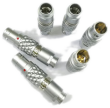The value of a wind turbine (WT) is not only measured by the investments into machines and site development, but also in the way it is used later. In the long run, components which simplify installation and maintenance can improve the value of the plant enormously. If a wind turbine manufacturer uses pluggable connectors for the electrical connections between plant modules, this can lower both the investment costs (CAPEX) and the operational costs (OPEX).

A good example of a regularly replaced component on a WT is the slip ring – the interface between the stationary nacelle and rotating hub. The slip ring is used to transmit the signals for the pitch systems that determine the angle of incidence of the rotor blades.
The plug solution offers many advantages over permanently attached wiring. The slip ring can be replaced more quickly, thereby reducing downtimes.
During maintenance in the service workshop, the slip ring can be replaced without intervention in the pitch system and without dismantling the connecting cables. The service fitters in the nacelle do not require special tools. This reduces costs for maintenance and repair.
There are good cost-saving opportunities associated with using plug connectors for the initial investments as well as the installation costs. Power cabinets in the WT are still mostly hardwired. They are hardwired and tested during assembly in the factory, then the connections are disconnected and restored at the system level in order to repeat the process after a further disconnection in the field.
Your benefits at a glance:
- Reduction in investment costs for wind turbines (CAPEX)
- Optimisation of operating costs of wind turbines (OPEX)
- Faster installations at wind turbines
- Efficient maintenance and repair without special tools




